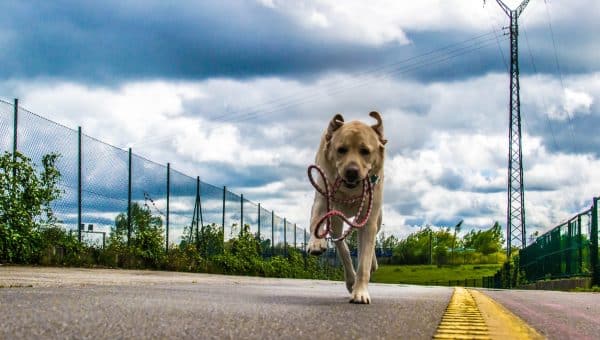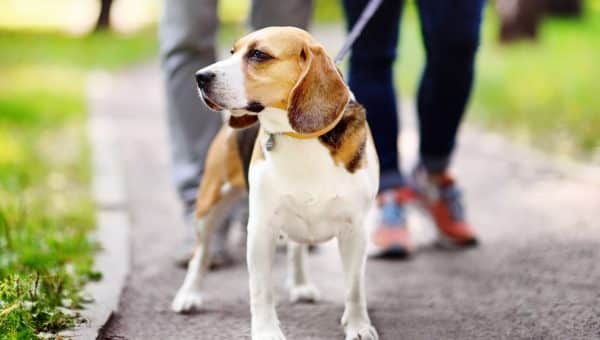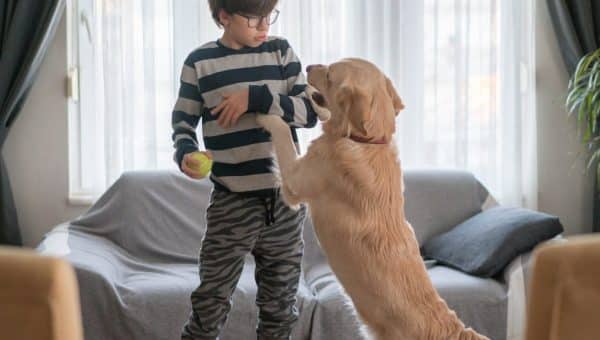- This post contains affiliate links. Read more here.
When trainer Eleasha Gall recommended a Pilates-style workout called FitPAWS in a recent Rover post on apartment living, we had to take a closer look. After all, what’s cuter than a dog on a fitness donut?
First, it isn’t technically Pilates. Your dog will not be doing the 100 or strapping in next to you at the local studio. However, the canine-specific fitness products that FitPAWS offers are quite similar to some of the balance and conditioning equipment humans use. FitPAWS president Krista Wickens explains that the practice first caught on “in dog performance circles and from there to the average pet owner.”
How dogs benefit from balance work
If you’ve ever sat on a ball instead of a desk chair, you know how it works. You have to think and engage different muscles to keep your balance. The same principal applies to dogs when they use strengthening and conditioning devices like:
“When you ask a dog to sit on a stable surface, gravity and momentum do the work,” Wickens says. “Now you put an unstable surface underneath and ask the dog to do the same thing. They are not actually thinking ‘I have to engage my core,’ but their body reacts to it.”
“They are not actually thinking ‘I have to engage my core,’ but their body reacts to it.”
It changes to whole mechanics of what’s going on,” Wickens says. “This tires the dog out a lot faster than just asking them to sit on the ground.”
Dr. Dicki Kennedy, who runs the Animal Rehab & Conditioning Center in Simpsonville, SC. has been using balance equipment in her practice for over a decade.
“This equipment strengthens the shoulders, the abdomen, the back and the back legs because the whole time, they’re having to figure out where they are in space,” she says.
Learning canine balance work
Using these products for injury rehabilitation is best left to the pros, but if canine fitness is your goal, there are plenty of resources. Keep in mind that there are important safety considerations for you and your dog, and that you should start slow, with plenty of treats.
“Clients need to get instruction on how to properly use the equipment so they don’t injure their dogs,” says trainer Bobbie Lyons of Pawsitive Performance in Portland, Oregon. “Even with the smaller pieces you can do things wrong.”
FitPAWS teamed up with the University of Tennessee to develop strict certification programs for canine rehabilitation professionals and trainers and provides a directory of coaches on their website. They also offer online classes for owners who don’t have a local coach.
Lyons got advanced certification through FitPAWS and now teaches via workshops, online classes, and one-on-one distance learning sessions. “My performance dogs see improved speed on the course and improved jumping. Basically anything that has to do with their performance is improved by using more muscles in their movement,” she says.
She adds that pet dogs also see benefits, which can extend to the owners as well. These include:
- Stabilizing shoulder joints
- Reducing stress on the dog’s body
- Injury prevention
Balance work and older dogs
Dr. Ilana Strubel, a veterinarian who runs A Well Adjusted Pet in Pacifica, Calif., and teaches Senior Pup-Pilates through the SPCA in San Francisco, says dogs of any age gain muscle through balance work.
“You always have to think about the level of skill of any dog starting a conditioning program but especially an older dog,” Strubel says, “And test them for what level/degree of intensity and how many repetitions they can safely perform based on their baseline individual fitness as well as any ongoing injuries. Then we tailor the workout to that individual dog.”
How to get started: tips from the experts
Your dog doesn’t have to be a pro to benefit, though you might love it so much you advance to a home agility kit. Here are some suggestions for starting balance work with your pet from the experts we spoke to:
- Ask your vet if your dog is healthy enough to start any new exercise program.
- Use the right size equipment. You don’t want a large dog to arch, so having them put all four feet on a small disc is not a good idea.
- Use a harness if you are introducing a dog to a higher piece of equipment.
- Start an older dog with a balance pad, which is not as wiggly as a disc, and they’ll be more comfortable with it.
- Make it fun, use treats, and keep sessions to five minutes once or twice a day.






